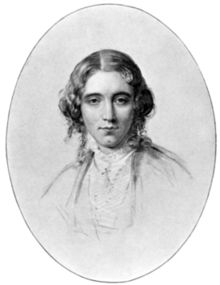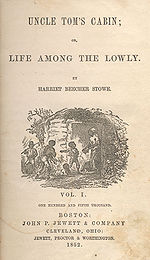

|
mNo edit summary
|
|
||
| Line 44: | Line 44: | ||
[[Harriet Beecher Stowe House (Ohio)|The Harriet Beecher Stowe House]] in [[Cincinnati, Ohio]] is the former home of her father Lyman Beecher on the former campus of the Lane Seminary. Harriet lived here until her marriage. It is open to the public and operated as an historical and cultural site, focusing on Harriet Beecher Stowe, the Lane Seminary and the [[Underground Railroad]]. The site also presents [[African-American]] history. The Harriet Beecher Stowe House in Cincinnati is located at 2950 Gilbert Avenue, Cincinnati, OH 45206. [http://www.ohiohistory.org/places/stowe/] |
[[Harriet Beecher Stowe House (Ohio)|The Harriet Beecher Stowe House]] in [[Cincinnati, Ohio]] is the former home of her father Lyman Beecher on the former campus of the Lane Seminary. Harriet lived here until her marriage. It is open to the public and operated as an historical and cultural site, focusing on Harriet Beecher Stowe, the Lane Seminary and the [[Underground Railroad]]. The site also presents [[African-American]] history. The Harriet Beecher Stowe House in Cincinnati is located at 2950 Gilbert Avenue, Cincinnati, OH 45206. [http://www.ohiohistory.org/places/stowe/] |
||
The Stowe Family in Florida. "In the 1870s and 1880s, Harriet Beecher Stowe (1811-1896) and her family wintered in Mandarin |
The Stowe Family in Florida. "In the 1870s and 1880s, Harriet Beecher Stowe (1811-1896) and her family wintered in [[Mandarin, Florida|Mandarin]], south of downtown [[Jacksonville]] on the [[St. Johns River]]. Best known for ''Uncle Tom's Cabin'', Stowe wrote ''Palmetto Leaves'' while living in Mandarin. It was published in 1873 and describes Northeast Florida and its residents. In 1870, Stowe created an integrated school in Mandarin for children and adults. This was an early step toward providing equal education in the area and predated the national movement toward integration by more than a half century. The marker commemorating the Stowe family is located across the street from the former site of their cottage. It is on the property of the Community Club, at the site of a church where Stowe's husband once served as a minister." (Source: Florida Women's Heritage Trail, 2001) |
||
== Partial list of works == |
== Partial list of works == |
||
Harriet Beecher Stowe.
| |
|---|---|
 | |
| Born | June 14, 1811 |
| Died | July 1, 1896 |
| Occupation | Writer |
Harriet Elizabeth Beecher Stowe (June 14, 1811 – July 1, 1896) was a white American abolitionist and novelist, whose Uncle Tom's Cabin (1852) attacked the cruelty of slavery; it reached millions as a novel and play, and became influential as well in Britain. It made the political issues of the 1850s regarding slavery tangible to millions, energizing anti-slavery forces in the North. It angered and embittered the South. The impact was summed up by Abraham Lincoln when he met Stowe, "So you're the little woman who wrote the book that made this great war!"[1]
Born in Litchfield, Connecticut, she was the daughter of Lyman Beecher, an abolitionist Congregationalist preacher from Boston, and Roxana Foote Beecher, and the sister of renowned minister, Henry Ward Beecher. She had two other prominent and activist siblings, a brother, Charles Beecher, and a sister, Isabella Beecher Hooker. In 1832, her family moved to Cincinnati, another hotbed of the abolitionist movement, where her father became the first president of Lane Theological Seminary. There she gained second-hand knowledge of slavery and the Underground Railroad and was moved to write Uncle Tom's Cabin, the first major American novel with an African-American hero. She never visited a plantation, but did talk with former slaves.
In1836 Harriet Beecher married Calvin Ellis Stowe, a clergyman and widower. They moved to Brunswick, Maine, when he became a professor at Bowdoin College. Harriet and Calvin had seven children, but four of the seven died before she did. Her first children, twin girls Hattie and Eliza, were born on September 29, 1836. Four years later, in 1840, her son Frederick William was born. In 1848 the birth of Samuel Charles occurred, but in the following year, he died during a cholera epidemic. Because of the pain she felt when she lost her son Samuel, she attributed it to how a mother in slavery would have felt being sold away from her children at the selling block. This was the biggest factor behind her writing Uncle Tom's Cabin, seen in her character Eliza Harris who runs away from slavery when her son was going to be sold away from her.
In 1850, the passage of the Fugitive Slave Law stirred Stowe to the abolitionist side. Her sister-in-law wrote her saying, "Harriet, if I could use a pen as you can, I would write something that would make this whole nation feel what an accursed thing slavery is." After reading this aloud to her children Harriet dramatically crumpled the paper in her hand and said, "I will write something if I live." While at church she is said to have had a vision of "Uncle Tom's death" and was reportedly moved to tears. Immediately she went to her home and started writing her book.
Stowe began researching slavery. She interviewed slaves and slave owners with all points of views, and read several books. Later in 1851, with the help of William Lloyd Garrison, the editor of the abolitionist newspaper The Liberator, Stowe began publishing fictional sketches. These appeared in serialised form during 1851 in the Cincinnati abolitionist newspaper, The National Era under the title "Uncle Tom's Cabin" or "Life Among the Lowly". Her main character is widely believed to have been based on Josiah Henson who published his own account of being enslaved. After prompting from readers and her husband, who believed in her story's power to change the mind, she published her sketches as a two volume book in 1852. Within a week of its release in the U.S., her book sold a phenomenal 10,000 copies, and 300,000 the first year. Sales were even higher in Britain. By 1854, her book was translated into 60 different languages.

Stowe's book had an astounding effect on the Northern states of America. Thousands more flocked to the abolitionist side. However, the rift dividing the north and south deepened. The south denied that the book was a true account of southern life, and took it as an accusation. The south even went to such severe measures as to ban the book and arrest anyone in possession of it. In their defense the south wrote mocking books praising the good of slavery such as "Aunt Phillis's Cabin; or Southern Life as it is." In response Stowe gathered all her information and wrote, "A Key to Uncle Tom's Cabin." This book was written to prove she researched her topic. Yet, though written to the south, it was not read as widely there as elsewhere.
However, all the way across the AtlanticinGreat Britain the message of Uncle Tom was also embraced, supported from its inception by the powerful advocate Rev. James Sherman in London. In 1853 Harriet went on a tour of Europe, speaking on her book. Upon her arrival in England she was given a very warm welcome and was presented with an address, known as the Affectionate and Christian Address, from the Anti-Slavery Society, with over half a million signatures from noble women, down to the peasants. This was given to her in 26 volumes; her reply was printed in the Atlantic Monthly. The head of the Anti-Slavery Society, the Duchess of Sutherland, became very close friends with Harriet as well.
At the beginning of the American Civil War in 1861, Great Britain's consideration to join the South in this onslaught moved Stowe to reply to the British people reminding them of their commitment to the slaves. Britain remained neutral throughout the war. In her journal Stowe wrote about her feelings about the War. She said, 『It was God’s will that this nation—both North and South—should deeply and terribly suffer for the sin of consenting to and encouraging the great oppressions of the South…the blood of the poor slave, that had cried so many years from the ground in vain, should be answered by the blood of the sons from the best hearthstones through all the free states.』In 1862, Stowe went to see Lincoln to pressure him to free the slaves faster. Her daughter Hatty, who was present at the meeting between Stowe and Lincoln, reports the first thing Lincoln said was, "So you're the little lady who wrote the book that started this great war."

Harriet Beecher Stowe later said in her journal, "I wrote what I did because as a woman, as a mother I was oppressed and brokenhearted, with the sorrows and injustice I saw, because as a Christian I felt the dishonor to Christianity because as a lover of my country I trembled at the coming day of wrath." Many historians consider “Uncle Tom’s Cabin” a significant force in leading to the Civil War, which ended in the abolition of slavery in America. She aided runaway slaves after the passage of the Fugitive Slave Law. Following the Civil War she built and established several schools and boarding homes for newly freed slaves. Harriet Beecher Stowe’s influence reached people of all walks of life, from government officials, to nobility, down to the common man. In her lifetime she wrote prolifically, yet her influence went beyond words. A book she wrote entitled "How to Live on Christ" so impacted the missionary Hudson TaylorinChina, that he sent a copy of the book to each member serving with the China Inland Mission in 1869.
Harriet then moved back to Hartford, Connecticut into a community called Nook Farm. She lived there for the last 23 years of her life. Harriet Beecher Stowe died on July 1, 1896 and, like Rosa Parks of our time, was given a dignitary’s funeral. She was buried on the grounds of Phillips AcademyinAndover, Massachusetts.[2]
The Harriet Beecher Stowe HouseinHartford, Connecticut is the house where Harriet lived for the last 23 years of her life. In this 5,000 sq. ft. cottage style house, there are many of Harriet's original items and items from the time period. In the research library, which is open to the public, there are numerous letters and documents from the Beecher family. The house is opened to the public and offers house tours on the half hour. [1]
The Harriet Beecher Stowe HouseinCincinnati, Ohio is the former home of her father Lyman Beecher on the former campus of the Lane Seminary. Harriet lived here until her marriage. It is open to the public and operated as an historical and cultural site, focusing on Harriet Beecher Stowe, the Lane Seminary and the Underground Railroad. The site also presents African-American history. The Harriet Beecher Stowe House in Cincinnati is located at 2950 Gilbert Avenue, Cincinnati, OH 45206. [2]
The Stowe Family in Florida. "In the 1870s and 1880s, Harriet Beecher Stowe (1811-1896) and her family wintered in Mandarin, south of downtown Jacksonville on the St. Johns River. Best known for Uncle Tom's Cabin, Stowe wrote Palmetto Leaves while living in Mandarin. It was published in 1873 and describes Northeast Florida and its residents. In 1870, Stowe created an integrated school in Mandarin for children and adults. This was an early step toward providing equal education in the area and predated the national movement toward integration by more than a half century. The marker commemorating the Stowe family is located across the street from the former site of their cottage. It is on the property of the Community Club, at the site of a church where Stowe's husband once served as a minister." (Source: Florida Women's Heritage Trail, 2001)